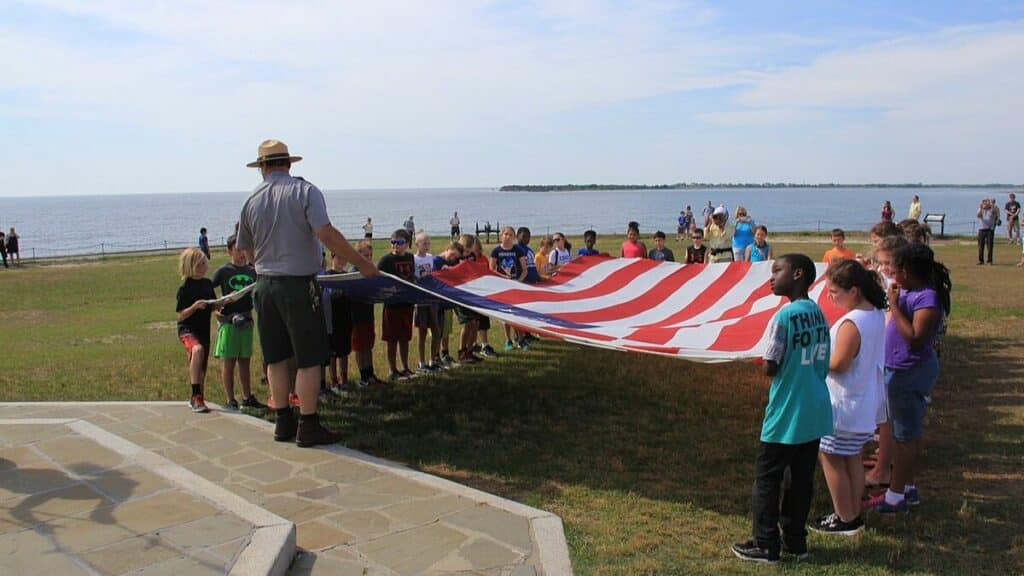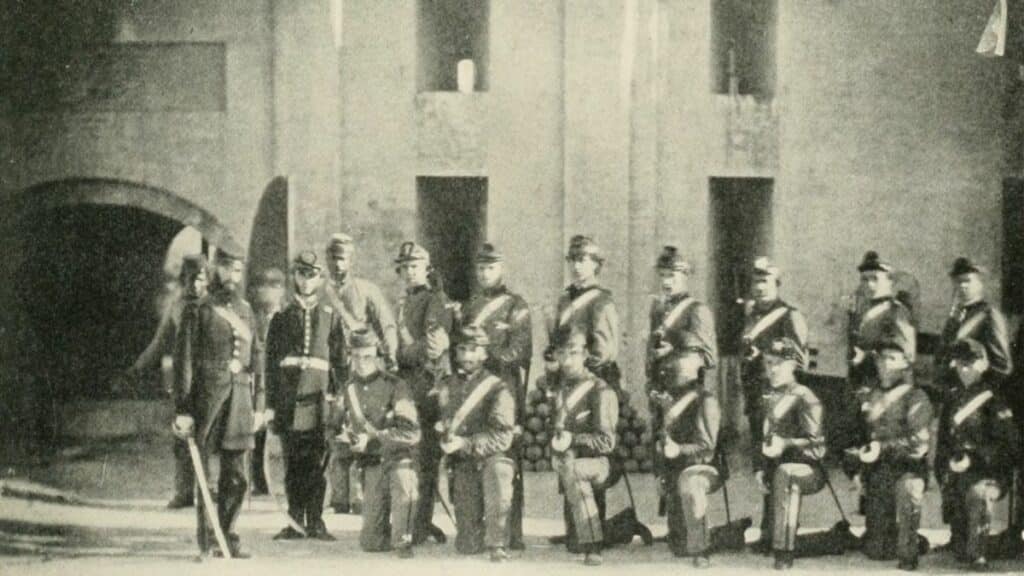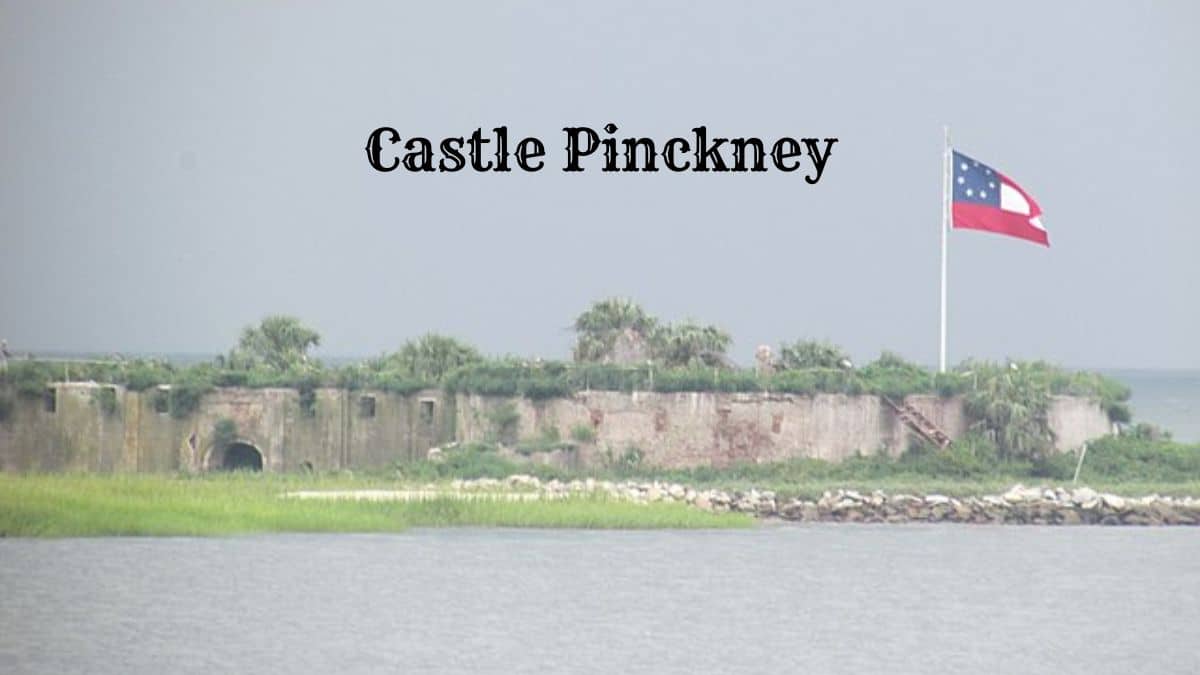Castle Pinckney, located in Charleston, South Carolina, is a small but significant historic site with a rich history.
Initially constructed in 1808, it served various roles throughout the 19th and early 20th centuries, including as a fort, prison, and lighthouse.
Visitors to Charleston may find it intriguing to learn about Castle Pinckney’s involvement in the Civil War and its strategic importance during that period.
Its small size belies its critical role in defending Charleston Harbor, making it an exciting landmark for history enthusiasts and casual tourists.
Today, Castle Pinckney reminds us of Charleston’s complex past and offers a unique window into American history.
This former defensive structure continues to attract the interest of those who want to explore the layers of history that have shaped the region.
Castle Pinckney’s Maritime History

Castle Pinckney holds a crucial place in American History, serving different roles during key periods such as the Revolutionary War, the War of 1812, and the Civil War.
Its historical importance reflects its strategic use by various military forces, including the British, Federal, and Confederate troops.
Revolutionary War Context
Castle Pinckney’s location in Charleston Harbor was pivotal during the Revolutionary War. Fort Moultrie, situated nearby, saw significant engagement with British forces.
The defense of these fortifications was imperative in protecting the vital port city of Charleston.
The garrison at Castle Pinckney played a role in deterring enemy advances.
While it may not have been the primary battleground, its significance lay in its strategic positioning in a fortified network protecting Charleston from British incursions.
War of 1812 and the Nullification Crisis
Castle Pinckney was fortified during the War of 1812 to deter any potential British attack and protect Charleston Harbor.
The fort’s garrison was equipped with cannons and other artillery, enhancing its defensive capabilities.
Even though Charleston did not see direct conflict, Castle Pinckney’s readiness was crucial.
Later, during the Nullification Crisis in the early 1830s, Castle Pinckney symbolized Federal authority.
President Andrew Jackson’s administration used the fort to affirm Federal power over states advocating for nullification. This period highlighted the fort’s role in upholding national unity.
Civil War And Confederate Use
In the Civil War, Castle Pinckney witnessed significant activity. It was one of the first Southern fortifications seized by Confederates following South Carolina’s secession.
Confederate forces used it for prisoner detention and as a supply depot.
Its proximity to Fort Sumter, where the first shots of the Civil War were fired, amplifies its historical role.
As Union forces blockaded Charleston Harbor, Castle Pinckney switched roles from active defense to logistical support.
Its strategic importance was evident as it supported Confederate efforts to protect Charleston, a critical port city.
Castle Pinckney in American Conflicts

Castle Pinckney’s involvement in American conflicts, especially during the Civil War, significantly influenced Charleston Harbor. This masonry fort became a strategic point for both Union and Confederate forces.
Role During the Civil War
Castle Pinckney played a vital role in the Civil War. Initially controlled by Union soldiers, it was soon seized by Confederate forces in December 1860. The fort’s location made it essential to control access to Charleston Harbor.
Confederate forces utilized Castle Pinckney to shore up their defenses around Charleston.
After its capture, it primarily served as a prison for Union soldiers.
Its strategic importance was evident through the continuous efforts from both sides to maintain control over it.
The fort endured attacks and served as a key point in the defense strategy for the Confederates.
Though not as famous as Fort Sumter, Castle Pinckney’s role was crucial in the broader military objectives during the Civil War.
Impact on Charleston Harbor
Castle Pinckney’s presence directly impacted the security and control of Charleston Harbor.
Its position allowed Confederate forces to monitor and regulate sea traffic, making it difficult for Union forces to conduct successful naval operations.
The fort’s strategic importance was magnified due to its location on Shutes’ Folly, a small island in the harbor.
This positioning provided a vantage point to safeguard against invasions.
The masonry structure of Castle Pinckney added to its defensive credibility, contributing significantly during sieges.
Architectural Features

Castle Pinckney, a coastal fortification in Charleston Harbor, is a notable example of early American masonry fort design.
Key architectural elements include its robust fortifications, well-constructed casemates, and strategically placed armaments for defense.
Masonry Fort Design
Castle Pinckney is constructed using a combination of brick and tabby, a type of concrete made from lime, sand, and oyster shells. These materials provided both durability and ease of construction in the coastal environment.
The design follows a circular plan, allowing for effective defense and a compact layout.
The thick walls ensure they can withstand enemy fire and the elements.
Openings in the walls serve as embrasures for cannons, providing offensive and defensive capabilities.
Fortifications and Casemates
The fortifications at Castle Pinckney include a surrounding wall and bastions oriented towards the water.
Bastions are angular structures projecting outward to allow defensive fire along the walls.
Within the thick walls, casemates were built to house soldiers and store supplies.
Casemates are vaulted chambers that are reinforced to withstand bombardment.
They serve as living quarters, storage for ammunition, and additional protection for the fort’s inhabitants.
Casemates also provide a secondary line of defense, protecting soldiers from incoming fire.
Armaments and Defense
Castle Pinckney was equipped with various armaments designed to defend Charleston Harbor.
The primary weapons were large cannons positioned strategically around the fort’s perimeter.
Cannons were mounted on rotating carriages, allowing for a broad range of fire.
The placement of these cannons ensured the fort could cover multiple angles of approach, effectively controlling access to the harbor.
Additional defensive measures included ramparts and parapets to provide cover for soldiers operating the cannons.
These architectural and defensive features made Castle Pinckney a critical element in coastal defense during its operational years.
Preservation Efforts and Challenges

The preservation of Castle Pinckney involves several key entities and faces significant challenges. Efforts focus on maintaining historical integrity, securing funding, and mitigating natural disaster impacts.
Historical Preservation Society
The Castle Pinckney Historical Preservation Society plays a central role. Established to safeguard the fortress, this society focuses on fundraising and awareness campaigns.
They organize events, tours, and educational programs to gather community support and increase public interest.
The society has launched multiple restoration projects.
They have continued to maintain and restore the exterior and interior of the fortress, ensuring its structural integrity.
Partnering with local historians and architects, they strive to preserve the site’s historical authenticity.
National Park Service Involvement
The National Park Service (NPS) involvement includes technical expertise and resources. Although limited, their support is essential for long-term preservation.
The NPS has provided grants and technical assistance to restore Castle Pinckney.
The listing of Castle Pinckney on the National Register of Historic Places underscores its significance.
This listing helps secure funding and ensure compliance with preservation standards.
The NPS also facilitates broader outreach initiatives to educate the public about the historical value.
Impact of Natural Disasters
Natural disasters, particularly hurricanes, pose substantial challenges. Castle Pinckney’s coastal location makes it vulnerable to harsh weather conditions.
Hurricanes and storm surges have caused significant damage over the years, affecting the structure’s stability.
Efforts to protect Castle Pinckney from future disasters include reinforcing the existing structures and installing modern protective measures.
Emergency response plans are also in place to address potential damage swiftly.
Collaboration with meteorologists and environmental engineers helps prepare for and mitigate the impact of natural disasters.
Castle Pinckney and National Identity

Castle Pinckney is steeped in American history. It served as a symbol during the Civil War, and its historical significance makes it an important landmark for understanding national identity.
Symbolism in American History
Castle Pinckney played a notable role during the Civil War. Located in Charleston, South Carolina, it was initially under Union control before being seized by Confederate forces in 1860.
This shift marked a turning point in the conflict’s early days.
The fort’s capture symbolized the growing tensions between the North and South.
Its presence in the Charleston Harbor became a reminder of the strife and division that characterized the era.
The fort’s usage throughout the war reinforces its significance as an emblem of American history during intense conflict.
Castle Pinckney as a National Monument
Efforts have been made to preserve Castle Pinckney as a national monument. Its status as an early federal fortification highlights its historical importance.
In 1924, it gained recognition from the War Department but later saw periods of neglect.
Declaring the site a national monument emphasizes its role in American heritage.
As a preserved landmark, it is a physical reminder of the Civil War’s impact on national identity.
Recognition helps educate the public about the war’s complexities and the site’s significance.
Castle Pinckney Today

Castle Pinckney, located in Charleston Harbor, is significant in tourism, education, ownership, and public access.
Tourism and Education
The site attracts history enthusiasts and tourists interested in the rich past of Charleston, South Carolina.
Guided tours offer insights into the fort’s history, from its construction after the War of 1812 to its Civil War role.
Informational plaques and exhibits enhance visitors’ experiences by providing detailed historical context.
Educational workshops and reenactments are also often held, engaging locals and visitors.
Ownership and Management
Owned by the South Carolina State Ports Authority, Castle Pinckney’s management focuses on preservation and responsible tourism.
The fort is being considered for inclusion in the National Park System, enhancing its funding and preservation efforts.
Collaboration with local historical societies supports ongoing research and restoration projects, ensuring the fort remains a well-maintained historical landmark.
Public Access and Visibility
Public access to Castle Pinckney is facilitated through boat tours from Charleston’s waterfront.
While direct access to the interior is limited to guided tours, the fort’s exterior is visible from various vantage points around the harbor.
Efforts are underway to improve accessibility and promote the site more widely, ensuring that locals and tourists can appreciate its historical significance.
Notable Figures and Events
Castle Pinckney has hosted various notable figures and significant events. Key individuals involved include Charles Cotesworth Pinckney and several U.S. Presidents.
The castle has had a diverse history, marked by the involvement of militia groups.
Charles Cotesworth Pinckney

Charles Cotesworth Pinckney was a prominent figure in American history. He was a notable statesman and a signer of the U.S. Constitution.
Pinckney’s military career included service in the Revolutionary War, when the British captured and held him prisoner.
His legacy is commemorated through the naming of Castle Pinckney in his honor.
Pinckney was also a diplomat, serving as the U.S. Minister to France.
His negotiation efforts during the XYZ Affair showcased his commitment to American interests.
His contributions to both military and diplomatic fields left a lasting impact on the nation.
Presidents and Commanders
Several U.S. Presidents have been connected to Castle Pinckney.
George Washington approved the initial construction of the fortifications, emphasizing its strategic importance.
In the early 19th century, President Andrew Jackson recognized its potential for national defense during his tenure.
The fort also saw the leadership of Major Robert Anderson during the Civil War.
Anderson, famous for his command at Fort Sumter, ensured Castle Pinckney remained a point of defense for Union forces.
These leaders underscored the site’s military and historical relevance through their actions.
Historic Garrison and Militia
Castle Pinckney has housed various military units over the years.
Notable among these were the Meagher Guards and the South Carolina Militia.
These units played a significant role in the fort’s operational history, particularly during unrest and conflict.
The South Carolina Militia took control of Castle Pinckney early in the Civil War, marking a pivotal moment in its history.
The involvement of local and national military groups highlights the fort’s continuous strategic significance.
Explore More: 10 Historic Forts in South Carolina
Cultural and Social Impact
Castle Pinckney’s influence extends beyond its physical structure, deeply impacting social frameworks and cultural narratives.
Its role in literature, media, and educational efforts highlights its enduring legacy.
Literature and Media Representations
Castle Pinckney has appeared in various literary works, emphasizing its historical significance.
Historians often reference the site in books about the Civil War and Southern history.
Films and documentaries depict the castle’s architecture and strategic military use, adding another layer to its cultural presence.
The castle is featured in writings by the Sons of Confederate Veterans, reflecting on heritage and memory.
These references shape public understanding of its role during key historical events, making it a symbol of broader cultural themes.
Educational Programs and Partnerships
Educational initiatives centered on Castle Pinckney offer valuable insights into American history. Schools and universities collaborate with historical societies to create learning materials about the site.
Field trips and interactive programs provide students with immersive experiences.
Partnerships with organizations like the Sons of Confederate Veterans aim to preserve and teach the significance of Castle Pinckney.
These efforts help maintain the site’s educational value, ensuring that future generations can learn from its storied past.

Cory is a website owner and content creator who enjoys fishing, history, coin collecting, and sports, among other hobbies. He is a husband and father of four.
Romans 15:4 For whatever was written in former days was written for our instruction, that through endurance and through the encouragement of the Scriptures we might have hope.

